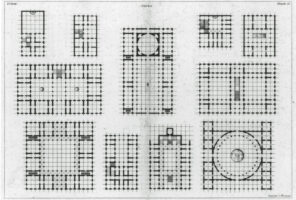Profession
Published as Timmermansoog column, website Architectenweb, 2020
Architecture easily succumbs to questions about its nature. Is the profession an art, a science or social action? or perhaps a little bit of everything? These are not just any old questions. They express an urge to confer meaning. I am not so worried about that. Architecture would not be any different if it became a science tomorrow. Architecture is just architecture.
Gerard van Zeijl’s PhD thesis on the French architect Jean-Nicolas-Louis Durand (1760-1834) is a case in point (OASE 22 carried a summary). Durand became a professor at the Polytechnic School in Paris in 1795. Then in 1802 and 1805 he published lecture summaries – the Précis des leçons données à l’École polytechnique – which were to become a standard treatise of architecture praxis. The Précis provided students with a design method. Questions of identity and meaning were pushed aside.

Van Zeijl claims that it is a misunderstanding that Durand turned his back on the past. What was new was his attitude towards history. This shifted from a search for the origins of architecture – for example in paradise, the Renaissance or in classical antiquity – towards the collection and classification of examples. These could be used by the architect to create a theoretically infinite series of designs.
Van Zeijl emphasises the political context in which the Précis arose. The French Revolution was around 15 years old. Architecture was no longer the monarch’s toy but had to serve the Republic. Durand studied the construction programme of schools, libraries, hospitals and even public housing. Architecture became a public issue that had to be understandable and sharable. Classical architecture was to monumentalise a new civic society. The tympanum no longer belonged to royalty but gave grandeur to public institutions, including schools and libraries. But, post-Revolution, architectural praxis needed modernisation.
For Durand, it was self-evident that economy, the availability of building materials and rationalised load-bearing structure would put limits on design. The Précis contains example layouts for new building programmes. Inevitably, these are based on familiar types, not styles. Grids allow for combinations and adaptations. No longer was the genius of the designer central to the profession.
The topicality of Durand’s relationship with the historical material of architecture is remarkable. I notice that architects are increasingly interested in architectural history. We have more or less finished ruminating on the Modernist canon, which is not very extensive in time or scope. As yet, this recent fascination with the history of architecture has not degenerated into connoisseurship of the columnar orders: for the time being, architecture is not served as expensive wine to epicureans.

An example is the catalogue to the 2017 Haussmann exhibition at the Pavillon de l’Arsenal in Paris, edited by the practising architects Benoit Jallon, Umberto Napolitano and Franck Boutte. It offers insights into the design principles of the Paris of 200 years ago by redrawing that city at all scales, from street furniture to urban plan. The accommodating capacity of the buildings plays a more emphatic role than what they signify.
Durand’s architecture was put on edge by the French Revolution. Actually, today’s interpreters might argue that he was already talking about the architecture of the city. He described a profession at the service of democratic public life. It was demystified; you could learn it, teach it, and pass it on. The craftsman did not work in back rooms; he had to account for his solutions in an economic, constructional and operational sense.

If, in the here and now, architects feel that they must regain ground, for example in social housing, then this rationalism seems to me to be fully applicable to their profession. Precisely now that public affairs have such a messy image (and even the democratic ideal itself is being thrown into question here and there), they cannot be transparent enough in the exercise of their profession. Individual genius is of no relevance. Durand shows that a publicly exercised architectural profession can achieve both utility and grandeur.
Text editing English translation: Charles Rattray
Literature
Gerard van Zeijl, Het gelijk van Durand, Oase #22
Benoît Jallon, Umberto Napolitano, Franck Bouttée, Paris Haussmann: A Model’s Relevance, catalogus tentoonstelling Haussmann, Park Books 2023
Zoom presentation
Lecture ‘Working with Type’, 100 Day Studio, Architecture Foundation
ll